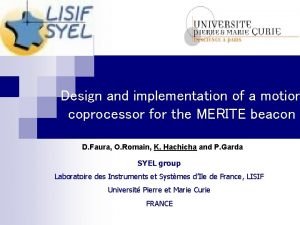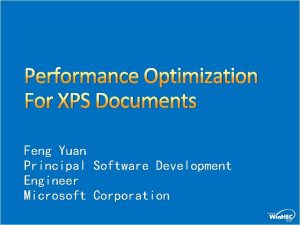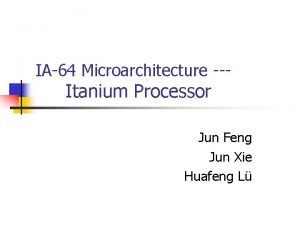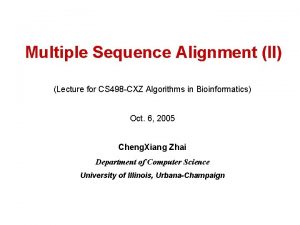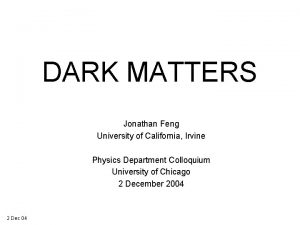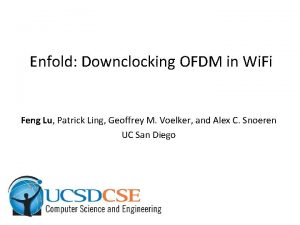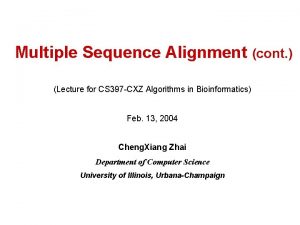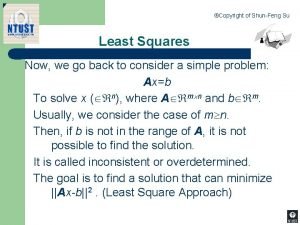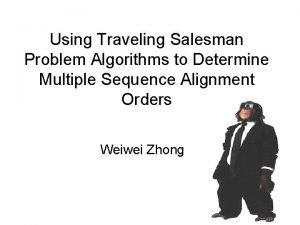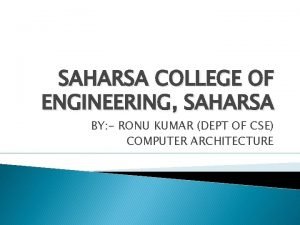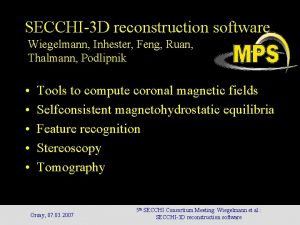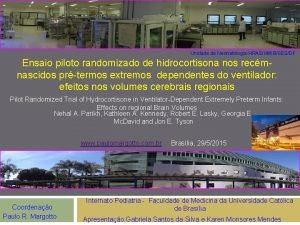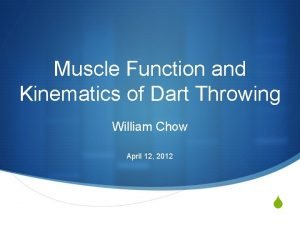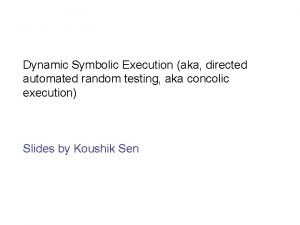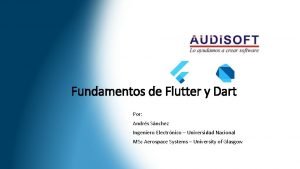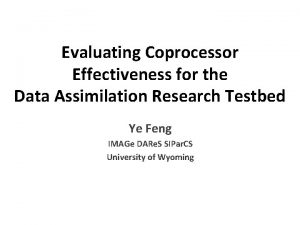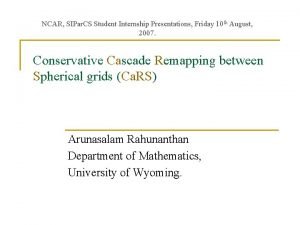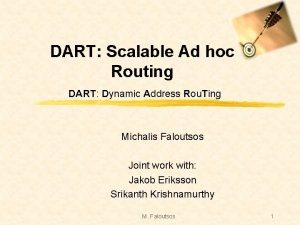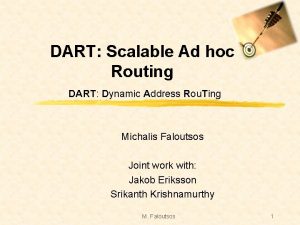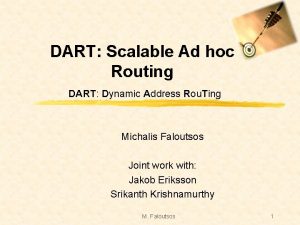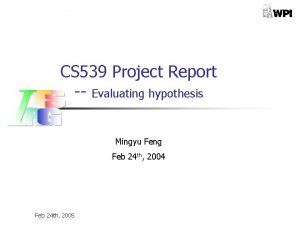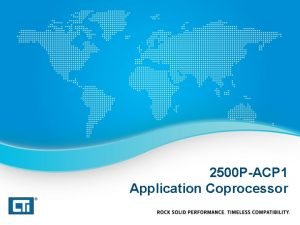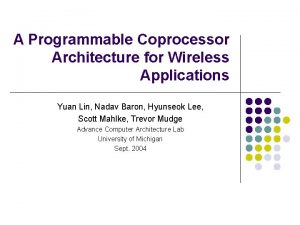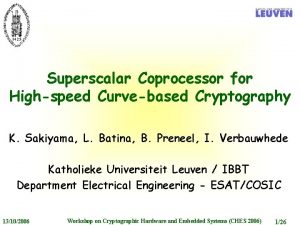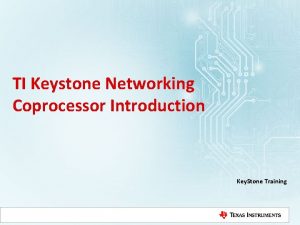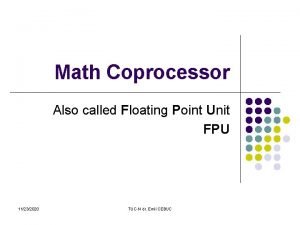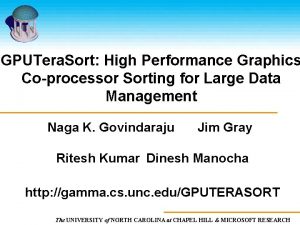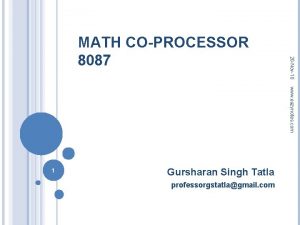Evaluating Coprocessor Effectiveness for DART Ye Feng SIPar


















![Algorithm • Not Enough Computation • sum(array[80]) • 79 sums • 7 steps (After Algorithm • Not Enough Computation • sum(array[80]) • 79 sums • 7 steps (After](https://slidetodoc.com/presentation_image/0dcc0e343c4100425a9bd4eabed89f32/image-19.jpg)


















- Slides: 37

Evaluating Coprocessor Effectiveness for DART Ye Feng SIPar. CS UCAR/NCAR Boulder, CO University of Wyoming Mentors Helen Kershaw Nancy Collins

Introduction • DART • Data Assimilation Research Testbed • Developed and maintained by the DARe. S at NCAR • GPU • NVIDIA Tesla K 20 x • CUDA FORTRAN • Previous Work • get_close_obs

Profiling Result • Allinea MAP wrf_regular_test_case

Profiling Result • Allinea MAP wrf_regular_test_case 33. 1% update_from_obs_inc 20. 6% get_close_obs

Target • update_from_obs_inc • Linear regression of a state variable onto an observation • Compute the state variable increments from observation increments State Obs_in c Update_from_obs_inc Reg_co ef State_in c

CPU Implementation 1 • For each close state: state_mean = sum(state) / ens_size obs_state_cov = sum( (state - state_mean) * (obs - obs_prior_mean) ) / (ens_size – reg_coef = obs_state_cov/obs_prior_var state_inc = reg_coef*obs_inc

CPU Implementation 2 A=obs-obs_prior_mean • For each close state: state_mean = sum(state) / ens_size A obs_state_cov = sum( (state - state_mean) * (obs - obs_prior_mean) ) / (ens_size – reg_coef = obs_state_cov/obs_prior_var state_inc = reg_coef*obs_inc

CPU Implementation 2 A=obs-obs_prior_mean • For each close state: state_mean = sum(state) / ens_size sum(state*A)-state_mean*sum(A) obs_state_cov = sum( (state - state_mean) * (obs - obs_prior_mean) ) / (ens_size – reg_coef = obs_state_cov/obs_prior_var state_inc = reg_coef*obs_inc

CPU Implementation 2 A=obs-obs_prior_mean • For each close state: (state_mean = sum(state) / ens_size) *sum(A) sum(state*A)-state_mean*sum(A) obs_state_cov = sum( (state - state_mean) * (obs - obs_prior_mean) ) / (ens_size – reg_coef = obs_state_cov/obs_prior_var state_inc = reg_coef*obs_inc

CPU Implementation 2 • For each close state: A=obs-obs_prior_mean D=sum(A) D (state_mean = sum(state) / ens_size) *sum(A) sum(state*A)-state_mean*sum(A) obs_state_cov = sum( (state - state_mean) * (obs - obs_prior_mean) ) / (ens_size – reg_coef = obs_state_cov/obs_prior_var state_inc = reg_coef*obs_inc

CPU Implementation 2 • For each close state: A=obs-obs_prior_mean D=sum(A) D (state_mean = sum(state) / ens_size) *sum(A) B E sum(state*A)-state_mean*sum(A) obs_state_cov = sum( (state - state_mean) * (obs - obs_prior_mean) ) / (ens_size – reg_coef = obs_state_cov/obs_prior_var state_inc = reg_coef*obs_inc

CPU Implementation 2 • For each close state: A=obs-obs_prior_mean D=sum(A) D (state_mean = sum(state) / ens_size) *sum(A) B E sum(state*A)-state_mean*sum(A) obs_state_cov = sum( (state - state_mean) * (obs - obs_prior_mean) ) / (ens_size – reg_coef = (E-B)/((ens_size-1)*obs_prior_var) state_inc = reg_coef*obs_inc

CPU Implementation 2 • For each close state: B=(sum(state) / ens_size)*D E=sum(state*A) reg_coef = (E-B)/((ens_size-1)*obs_prior_var) state_inc = reg_coef*obs_inc A=obs-obs_prior_mean D=sum(A)

CPU Implementation 2 • For each close state: B=(sum(state) / ens_size)*D A=obs-obs_prior_mean D=sum(A) B=sum(state*D/ens_size) E=sum(state*A) reg_coef = (E-B)/((ens_size-1)*obs_prior_var) sum(state*(A-D/ens_size))/((ens_size-1)*obs_prior_var) state_inc = reg_coef*obs_inc

CPU Implementation 2 • For each K=(ens_size-1)*obs_prior_var A=obs-obs_prior_mean D=sum(A) close state: M=A-D/ens_size B=(sum(state) / ens_size)*D B=sum(state*D/ens_size) E=sum(state*A) reg_coef = (E-B)/((ens_size-1)*obs_prior_var) sum(state*(A-D/ens_size))/((ens_size-1)*obs_prior_var) state_inc = reg_coef*obs_inc M K

CPU Implementation 2 • For each K=(ens_size-1)*obs_prior_var A=obs-obs_prior_mean D=sum(A) close state: M=A-D/ens_size reg_coef = sum(state*M)/K state_inc = reg_coef*obs_inc

CPU Results CPU Version Performance 18 16. 55509 Execution Time (msec) 16 14 13. 08524 12 10 CPU Implementation 1 8 CPU Implementation 2 6 4 2 0 2 k 5 k 10 k 20 k 40 k Number of Close States 60 k 80 k 100 k

Algorithm • For each K=(ens_size-1)*obs_prior_var A=obs-obs_prior_mean D=sum(A) close state: M=A-D/ens_size reg_coef = sum(state*M)/K state_inc = reg_coef*obs_inc
![Algorithm Not Enough Computation sumarray80 79 sums 7 steps After Algorithm • Not Enough Computation • sum(array[80]) • 79 sums • 7 steps (After](https://slidetodoc.com/presentation_image/0dcc0e343c4100425a9bd4eabed89f32/image-19.jpg)
Algorithm • Not Enough Computation • sum(array[80]) • 79 sums • 7 steps (After padding) • sum(array[4*1024]) • 4, 194, 304 sums • 22 steps www. manutritionniste. com en. wikipedia. org

Algorithm • Low CGMA • Compute to Global Memory Access ratio

CPU Implementation 1 • For each close state: state_mean = sum(state) / ens_size obs_state_cov = sum( (state - state_mean) * (obs - obs_prior_mean) ) / (ens_size – reg_coef = obs_state_cov/obs_prior_var state_inc = reg_coef*obs_inc CGMA=1. 176 Float Point Operations Load Store 79+1 : 80+1 1 80+80+79+80+1 : 80+80+2 1 1 : 1+1 1 80 : 1+80 80

CPU Implementation 2 • For each K=(ens_size-1)*obs_prior_var A=obs-obs_prior_mean D=sum(A) close state: M=A-D/ens_size reg_coef = sum(state*M)/K state_inc = reg_coef*obs_inc Float Point Operations CGMA=0. 743 Load Store 79+80+1 : 80+80+1 1 80 : 1+80 80

GPU Implementation 1 thread i States … … ens_size state(: , i) … reg_coef (i) state_inc (: , i) num_close_states

GPU Implementation 1 H 2 D copy engine • Streams + Async. Memcpy Kernel engine time S 1 S 2 H 2 D D 2 H copy engine D 2 H www. zoombd 24. com S 3 H 2 D D 2 H

GPU Implementation 1 • Streams + Async. Memcpy time Memcpy D 2 H GPU kernel Memcpy H 2 D

GPU Implementation 1 • Streams + Async. Memcpy time Memcpy D 2 H GPU kernel Memcpy H 2 D Assumed-shape Array (: )

GPU Implementation 1 • Streams + Async. Memcpy time Memcpy D 2 H GPU kernel Memcpy H 2 D Assumed-size Array (*)

GPU Results GPU Version Performance 14 13. 08524 12. 39763 Execution Time (msec) 12 10 8 GPU Implementation 1 6 CPU Implementation 2 4 2 0 2 k 5 k 10 k 20 k 40 k Number of Close States 60 k 80 k 100 k

GPU Implementation 2 thread 1: ens_size States … … ens_size state(: , i) … reg_coef (i) state_inc (: , i) num_close_states

GPU Implementation 2 • Shared Memory Binary Tree 80 128 Ternary Tree 80 81

GPU Implementation 2 • Streams + Async. Memcpy time Memcpy D 2 H GPU kernel Memcpy H 2 D

GPU Results GPU Version Performance 14 13. 08524 12. 39763 Execution Time (msec) 12 12. 23195 10 8 GPU Implementation 1 GPU Implementation 2 6 CPU Implementation 2 4 2 0 2 k 5 k 10 k 20 k 40 k Number of Close States 60 k 80 k 100 k

GPU Implementation 3 Image: pixshark. com

GPU Implementation 3 B • GPU+CPU E • 4 -way concurrency B E time S 1 S 2 H 2 D D 2 H H 2 D S 3 CPU D 2 H reg_coef and state_inc

GPU Results GPU Version Performance 14 13. 08524 12. 39763 Execution Time (msec) 12 12. 23195 10 8 GPU Implementation 1 7. 058092 6 GPU Implementation 2 GPU Implementation 3 CPU Implementation 2 4 2 0 2 k 5 k 10 k 20 k 40 k Number of Close States 60 k 80 k 100 k

Conclusion • Reduced redundancy in the CPU version • GPU version achieved a 1. 9 x speedup • Explored the ways to implement a memory bound problem on GPU • Learned the effects of assumed-shape/size arrays on CUDA FORTRAN performance • Integrate more computations into the GPU device kernel to improve the performance

Acknowledgement • NCAR / UCAR • University of Wyoming • DARe. S: • • Jeff Anderson Nancy Collins Helen Kershaw Tim Hoar Kevin Raeder Silvia Gentile CISL/ SIPar. CS • Rich Loft • Raghu Raj Kumar Thank You!
 Motion coprocessor
Motion coprocessor Feng yuan microsoft
Feng yuan microsoft Intel itanium
Intel itanium Feng doolittle algorithm
Feng doolittle algorithm Fung joe guey
Fung joe guey Jonathan feng
Jonathan feng Feng suave vpro
Feng suave vpro Pupuk feng shou untuk ternak
Pupuk feng shou untuk ternak Feng shui
Feng shui Feng lu
Feng lu Feng doolittle algorithm
Feng doolittle algorithm Iridescent shards dead by daylight
Iridescent shards dead by daylight Shun-feng su
Shun-feng su Jonathan feng white & case
Jonathan feng white & case Zuofeng zhang
Zuofeng zhang Wayne feng
Wayne feng Feng doolittle algorithm
Feng doolittle algorithm Feng guo symmetry
Feng guo symmetry Dr connie feng
Dr connie feng Feng suave vpro
Feng suave vpro Saharsa college of engineering
Saharsa college of engineering Jonathan feng white & case
Jonathan feng white & case Feng shui floor plan analysis
Feng shui floor plan analysis Feng ruan
Feng ruan Victor van der veen
Victor van der veen Benefits of feng shui
Benefits of feng shui Esquema dart para extubação
Esquema dart para extubação Vx=vcosθ
Vx=vcosθ Dendrobates fantasticus
Dendrobates fantasticus Dart aiu
Dart aiu Dart: directed automated random testing
Dart: directed automated random testing Flutter primeros pasos
Flutter primeros pasos Http://www.dart-europe.eu/basic-search.php
Http://www.dart-europe.eu/basic-search.php Poison dart frog adaptations
Poison dart frog adaptations Esquema dart para extubação
Esquema dart para extubação Dart referral
Dart referral Parasitism examples
Parasitism examples Mimic poison dart frog
Mimic poison dart frog
